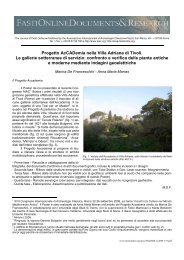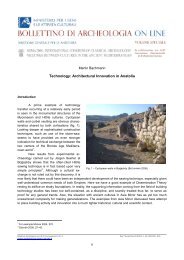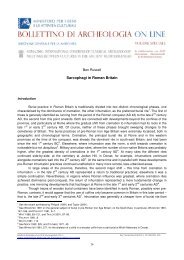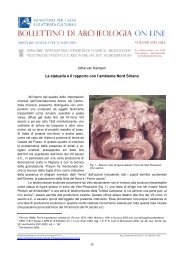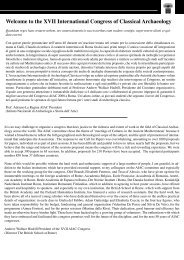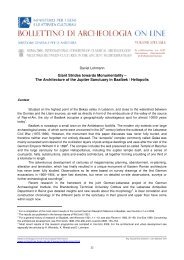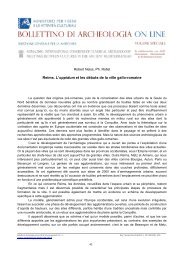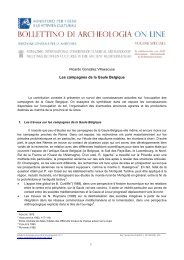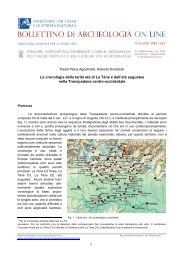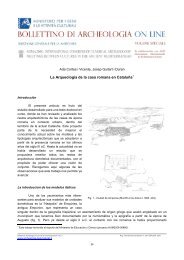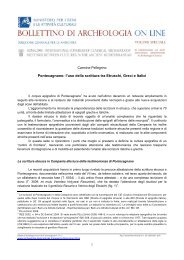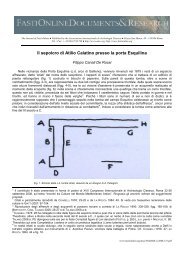Epidamnos, Dyrrachium, Dyrrachion - Bollettino di archeologia on line
Epidamnos, Dyrrachium, Dyrrachion - Bollettino di archeologia on line
Epidamnos, Dyrrachium, Dyrrachion - Bollettino di archeologia on line
Create successful ePaper yourself
Turn your PDF publications into a flip-book with our unique Google optimized e-Paper software.
XVII Internati<strong>on</strong>al C<strong>on</strong>gress of Classical Archaeology, Roma 22-26 Sept. 2008Sessi<strong>on</strong>: Interacti<strong>on</strong>, Urbanisati<strong>on</strong> and Cultural Change in the BalkansFig. 3 - I santuari arcaici e classici della chora <str<strong>on</strong>g>di</str<strong>on</strong>g> <str<strong>on</strong>g>Epidamnos</str<strong>on</strong>g>(elaborazi<strong>on</strong>e sulla base <str<strong>on</strong>g>di</str<strong>on</strong>g> DAVIS ET AL. 2003, fig. 6).<str<strong>on</strong>g>di</str<strong>on</strong>g> famiglie principesche locali, che intrattenevano giànel VII sec. a.C., e ancor più nel VI sec. a.C. intensirapporti c<strong>on</strong> il m<strong>on</strong>do egeo e pelop<strong>on</strong>nesiaco, testim<strong>on</strong>iatidai materiali dei corre<str<strong>on</strong>g>di</str<strong>on</strong>g> funerari 12 . Questosviluppo ec<strong>on</strong>omico, ancor più che la possibilità <str<strong>on</strong>g>di</str<strong>on</strong>g>sfruttare <str<strong>on</strong>g>di</str<strong>on</strong>g>rettamente le risorse ambientali, avevaattratto l’attenzi<strong>on</strong>e della col<strong>on</strong>izzazi<strong>on</strong>e greca suquesta costa, ancora avvolta da un’aura mitica legataalle imprese <str<strong>on</strong>g>di</str<strong>on</strong>g> Ercole, <str<strong>on</strong>g>di</str<strong>on</strong>g> Cadmo e all’oracolo deiMorti 13 .La col<strong>on</strong>ia <str<strong>on</strong>g>di</str<strong>on</strong>g> <str<strong>on</strong>g>Epidamnos</str<strong>on</strong>g> godeva <str<strong>on</strong>g>di</str<strong>on</strong>g> unaposizi<strong>on</strong>e particolarmente favorevole rispetto allepopolazi<strong>on</strong>i illiriche dell'interno, nei c<strong>on</strong>fr<strong>on</strong>ti dellequali svolgeva un ruolo <str<strong>on</strong>g>di</str<strong>on</strong>g> interme<str<strong>on</strong>g>di</str<strong>on</strong>g>azi<strong>on</strong>e commercialeche fu poi regolamentato anche istituzi<strong>on</strong>almenteattraverso la figura del poletés, funzi<strong>on</strong>ariopubblico preposto alla gesti<strong>on</strong>e del commercio c<strong>on</strong> gliIlliri 14 . L’ampia <str<strong>on</strong>g>di</str<strong>on</strong>g>ffusi<strong>on</strong>e della m<strong>on</strong>etazi<strong>on</strong>e <str<strong>on</strong>g>di</str<strong>on</strong>g> <str<strong>on</strong>g>Dyrrachi<strong>on</strong></str<strong>on</strong>g>fino in Dacia 15 , dalla fine del IV alla metà delI sec. a.C., mostra l’ampiezza della rete <str<strong>on</strong>g>di</str<strong>on</strong>g> commerciche da questo centro si irraggiava in epoca tardoclassica ed ellenistica. La col<strong>on</strong>ia, c<strong>on</strong> la sua collocazi<strong>on</strong>estrategica, risp<strong>on</strong>deva alla necessità <str<strong>on</strong>g>di</str<strong>on</strong>g> c<strong>on</strong>trollo<str<strong>on</strong>g>di</str<strong>on</strong>g> tre sistemi itinerari: quello delle rotte verso gliemporia nordadriatici <str<strong>on</strong>g>di</str<strong>on</strong>g> Adria e Spina (Strabo. VII, 5,10), già attivi nel VI sec. a.C. 16 che si svolgevarisalendo lungo la costa orientale c<strong>on</strong> alcuni “p<strong>on</strong>timarittimi” verso ovest (uno rappresentato dall’isola <str<strong>on</strong>g>di</str<strong>on</strong>g>Palagosa, un altro all’altezza del Delta del Po) 17 ;quello della strada transbalcanica, che determina la f<strong>on</strong>dazi<strong>on</strong>e c<strong>on</strong>temporanea delle due col<strong>on</strong>ie corinziocorciresiche ne costituivano i capo<strong>line</strong>a: <str<strong>on</strong>g>Epidamnos</str<strong>on</strong>g> e Potidea ed è <str<strong>on</strong>g>di</str<strong>on</strong>g>mostrata dalla presenza <str<strong>on</strong>g>di</str<strong>on</strong>g> materialiegei (Lesbo, Chio, Taso) a Epidamno 18 ; quello del collegamento transmarino c<strong>on</strong> la Magna Grecia, tramitequella rotta Brin<str<strong>on</strong>g>di</str<strong>on</strong>g>si-Durazzo <str<strong>on</strong>g>di</str<strong>on</strong>g> 1000 sta<str<strong>on</strong>g>di</str<strong>on</strong>g> che già al tempo della f<strong>on</strong>dazi<strong>on</strong>e della col<strong>on</strong>ia rendevaparticolarmente intensi i rapporti c<strong>on</strong> l’altra sp<strong>on</strong>da dell’Adriatico ed in particolare c<strong>on</strong> i Messapi e c<strong>on</strong>Taranto 19 . Nei secc. V e IV, questi rapporti s<strong>on</strong>o attestati dalla rilevante presenza <str<strong>on</strong>g>di</str<strong>on</strong>g> ceramiche italiote aDurazzo, dalle numerose affinità fra le statuette votive del santuario durrachino <str<strong>on</strong>g>di</str<strong>on</strong>g> Artemide (il più grossodeposito votivo del Me<str<strong>on</strong>g>di</str<strong>on</strong>g>terraneo in termini <str<strong>on</strong>g>di</str<strong>on</strong>g> peso e numero delle terrecotte) e la coroplasticatarantina 20 e dalla presenza a Durazzo nel III sec. a.C. <str<strong>on</strong>g>di</str<strong>on</strong>g> motivi funerari quali le sirene del tipo trauernde12 HAMMOND 1973, 93 c<strong>on</strong> bibliografia; ANTONELLI 2000, 73, n. 36 c<strong>on</strong> <str<strong>on</strong>g>di</str<strong>on</strong>g>scussi<strong>on</strong>e sui materiali br<strong>on</strong>zei rinvenuti in queste tombe,databili alla fine del VI sec. a.C., alcuni sicuramente <str<strong>on</strong>g>di</str<strong>on</strong>g> provenienza corinzia ma altri magnogreci, come i bacili ad orlo perlinato nelletombe principesche <str<strong>on</strong>g>di</str<strong>on</strong>g> Bosnia (Ilijak, Osovo) e Serbia (Novi Pazar) datati tra metà del VII e fine VI sec. a.C.: D’ERCOLE 2005, 95 n. 4.Per i br<strong>on</strong>zi lac<strong>on</strong>ici e corinzi <str<strong>on</strong>g>di</str<strong>on</strong>g> questi corre<str<strong>on</strong>g>di</str<strong>on</strong>g> e le due strade che poss<strong>on</strong>o averli c<strong>on</strong>dotti qui: STIBBE 2002.13 CABANES 2001b, 15–21.14 Plut., Quaest.graec., 29 e CABANES 1993, 145–153.15 MYRTO 1998, 93–96 e PICARD, GJONGEKAJ 2005.16 Per i materiali greci <str<strong>on</strong>g>di</str<strong>on</strong>g> prima metà del VI sec. a.C. a Spina e nel Delta Padano: LIPPOLIS 2000, BONOMI 2000.17D’ERCOLE 2005.18 CEKA 2003, 25.19Questo rapporto è stato oggetto del c<strong>on</strong>vegno <str<strong>on</strong>g>di</str<strong>on</strong>g> Taranto 1984: vd. KILIAN 1984 e anche LAMBOLEY 1993.20MULLER ET AL. 2004, 621–622.<str<strong>on</strong>g>Bollettino</str<strong>on</strong>g> <str<strong>on</strong>g>di</str<strong>on</strong>g> Archeologia <strong>on</strong> <strong>line</strong> I 2010/ Volume speciale C / C11 / 4 Reg. Tribunale Roma 05.08.2010 n. 330 ISSN 2039 - 0076www.<str<strong>on</strong>g>archeologia</str<strong>on</strong>g>.beniculturali.it/pages/pubblicazi<strong>on</strong>i.html25



